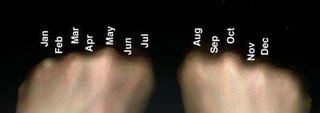Why is the alphabet in that order? Is it because of that song? - Stephen Wright

During dinner last night, my five-year old and my four-year old were embroiled in a spirited discussion (okay, they were fighting) over the A-B-C song. The older one, who is in kindergarten this year, has been taught that it ends with "Now I know my A-B-Cs, Next time won't you sing with me" while the younger one fervently maintained (okay, he was screaming in protest) that it was "Now I know my A-B-Cs, Won't you come and play with me".
Fortunately, before it evolved into fisticuffs, cooler heads prevailed and order was restored (okay, Mom and Dad told them both to can it pronto before they got sent to their room).
While I hadn't originally planned on blogging that particular moment of fraternal dischord, I include it here in the interest of context. It occurred to me that while just about any English-speaking child is taught the sing-songy alphabet song at an early age, I had no idea whether other languages had their own alphabet songs. Turns out a few do.
Yiddish Alphabet Songs
Greek Alphabet Song
More background and general history behind the A-B-C ditty so many of us have ingrained in our collective subconscious.
The reason the A-B-C song is still around in almost every English-speaking kindergarten room is because it is an easy and effective way to make the little guys remember the order of the letters. They just happen to fit into a kind of rhyme when set to that particular meter, making remembering the order the letters are supposed to go in easier to remember.
In general, we humans have found various little techniques, called mnemonics, to memorize seemingly random data in list form, whether it's the order of biologic taxonomy ("Kings Play Cards On Fat Green Stools" = Kingdom, Phylum, Class, Order, Family, Genus, and Species), the colors in the spectrum (Roy G. Biv = Red, Orange, Yellow, Blue, Indigo, Violet), etc.
Some mnemonics aren't even verbal. The picture below shows that most of us carry around a visual mnemonic of which months are long (knuckles) and which ones are short (space between the knuckles). Wikipedia has a nice list of some of the major mnemonics here.

Lastly, Tom Lehrer, satirist, pianist and mathematician (now there's a combo you don't find too often) wrote a little ditty in 1959 to help everyone remember all the known elements in the periodic table (102 at the time, more have been discovered since). Mike Stanfill turned it into a brilliant Flash animation a few years ago. Very clever!
Technorati tags: ABC song, language, mnemonics, Tom Lehrer, periodic table
No comments:
Post a Comment